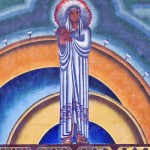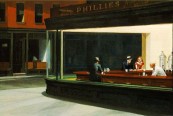Violence and Virtue on Display at the Art Institute of Chicago

Artemisia Gentileschi. Judith Slaying Holofernes, c. 1620. Galleria degli Uffizi, Florence, inv. 1567. Image courtesy of the Art Institute of Chicago.
Violence and Virtue: Artemisia Gentileschi’s “Judith Slaying Holofernes”
October 17, 2013 – January 9, 2014
The Art Institute of Chicago
“Violence and Virtue,” an exhibition at the Art Institute of Chicago is a unique opportunity to see Artemisia Gentileschi’s masterpiece Judith Slaying Holofernes (1611-12), which is normally displayed in Galleria degli Uffizzi in Florence, Italy. Gentileschi’s painting is shown along with other artwork focusing on the character of Judith, the biblical-legendary Jewish heroine. Prints and paintings tell the story of Judith to viewers, and allow them to compare how different artists approached the same topic over the course of history.
“The Book of Judith” is included in the Catholic and Eastern Orthodox Christian Old Testament, and excluded from the Hebrew Bible and most Protestant Bible editions as a non-canonical form of apocrypha. This story is an example of feminine power in a patriarchal world, as Judith, a virtuous widow, seduces Holofernes, a commander of the enemy’s army, in order to cut off his head. Judith’s character is outstanding because of her ambiguity. The Bible describes her as an ideal, a brave and god-fearing woman, but in the context of more contemporary moral values (Judith’s deed seemed perfectly fine for ancient Hebrew war ethics) her actions seem violent and rebellious.
For some male artists approaching the subject, the figure of a woman who leads a man to downfall using her beauty and wits, and is furthermore praised for this deed by her fellow countryman, was both horrifying and fascinating. In the nineteenth century, the violent and seductive Judith became a perfect example of femme fatale and was depicted exactly so in the famous Gustav Klimt’s painting Judith and the Head of Holofernes (1901). At the exhibition in the Art Institute, Sanders van Hemessen’s Judith (1540) represents the heroine in a similar way, though both paintings are much older than the concept of the femme fatale. Judith is shown naked and determined, with her sword raised up in a triumphant way. Nudity, however, is not mentioned anywhere in the Book of Judith. In fact, the story emphasizes that Holofernes fell asleep quickly and his plan to copulate with the beautiful widow never succeeded, thus leaving Judith’s virtue intact. Despite this fact, countless artists used her nudity as a tool to show the heroine’s sexuality and suggest it was a form of deception she used to kill the commander. Another example of this fascination with Judith and nudity is Hans Beham’s print Judith and Her Servant, in which both Judith and her servant Abra are naked, which does not occur in the original story, because Abra did not seduce Holofernes and had no reason to take off her clothes.
Although cutting off the head of a sleeping man seems horrifying (especially while looking at Gentileschi’s violent painting), Judith did this in order to save lives of all people in her hometown and prevent the temple in Jerusalem from being destroyed. The Book of Judith emphasizes this, suggesting that Judith saved the faith of all Israelites, as Holofernes planned to force them to worship his king instead of their God. This approach to her actions gives the heroine a sense of sacredness. Some scholars also state that Judith may be an allegory for all religious people in Israel, as her name etymologically means “Jewess” in Hebrew. Many historical facts mentioned in the book are incorrect, like Assyrian army trying to force the Hebrews to worship their king, because Assyrians usually allowed religious freedom on conquered lands. This makes the story a parable that emphasizes moral values rather than a description of actual historical facts.
In contrast to the image of Judith created by van Hemessen, the prints of the artist Jacopo de Barbari depict the “sacred” image of Judith. Barbari’s Judith is fully clothed and more traditionally feminine looking. Gentle lines are used to draw her figure. She holds Holofernes’ head with delicacy and turns away her eyes, as if she is pitying her victim. She is presented as if she was just obeying God’s will, rather than committing the act with passion. On the contrary, van Hemessen’s Judith is more active, masculine in her muscularity, and triumphant. These two pieces of art excellently show two sides of Judith: the violent and the virtuous.
Artemisia Gentileschi’s painting Judith Slaying Holofernes (1614-20) is a central focus of the exhibition. It stands out from the other displayed pieces in its giant size (67 in x 53.5 in) and is a naturalistic, if not violent, depiction of the murder. Other exhibited paintings and prints usually depict Judith after her deed, holding the head of Holofernes, or hiding it in a sack. These other representations of the topic do not expose brutality of the act. On the contrary, Gentileschi’s piece depicts the most lurid moment of his decapitation. Holofernes’ head is half cut off, his eyes are still open, and blood is spurting from his neck. The dynamic and dramatic scene is typical for the Baroque Period, that Gentileschi’s masterpiece comes from. Baroque style put a strong emphasis on shocking and engaging the audience’s feelings through emotionally stimulating scenes. Baroque artists were also inspired by theater: they used narrative, dynamism, and illusion in their work. This style is different from many of the Late Renaissance artist’s pieces included in the exhibition that preferred creating more static scenes.
Gentileschi’s Judith Slaying Holofernes was strongly influenced by Caravaggio’s Judith Beheading Holofernes (1598-1599 ). Their paintings share very similar qualities such as their choice of colors and usage of chiaroscuro lighting with deep contrasts of light and shadow. There are also similarities in their renditions of Judith’s gestures (like the way she holds Holofernes’ hair), and their depiction of the decapitation moment. Gentileschi painted her version of Judith’s story about twenty years after Caravaggio and has been described as a Caravaggisti or a stylistic follower of Caravaggio’s style. This style became fashionable in European Baroque painting, and the high demand for artwork similar to Caravaggio’s encouraged artists to paint in his manner. Orazio Gentileschi, Artemisia’s father from whom she learned painting was also the caravaggisti.
Judith’s act was a very popular choice of subject matter during the Renaissance and Baroque periods and her figure even appeared as a decorative element on plates (one of them is a part of the exhibition). In many ways, painting Judith in Caravaggio’s style must have been a commercial success for Artemisia, who made a living from her paintings. There is a theory that the fashionable and expensive dress worn by Judith in the painting was placed there, because the Medici family (famous Florentine patrons of art) favored pieces of art that depicted luxury. Gentileschi created a series of four paintings focused on Judith, including a second version of Judith Slaying Holofernes (on display in National Museum of Capodimonte, Naples) so she might have found the subject matter profitable.
However, her motivation for painting these passionate masterpieces was stronger than just meeting patron’s demands. Artemisia’s tutor, Agostino Tassi, was accused in court of raping her, so such a violent depiction of decapitation of Holofernes could be considered as the artist’s response to sexual violence she experienced. The art world was dominated by men in the seventeenth century, so Artemisia’s career was a constant struggle with gender prejudice. Female painters were treated as a “curiosity” rather than as an equal to their male counterparts. As Judith was a successful woman in a society dominated by men, Artemisia probably found her story compelling. The effort to gain power in a patriarchal environment might explain why Gentileschi painted Judith in a more violent way than most other artists did. Unlike Caravaggio, Artemisia did not depict moral ambiguity of the heroine, and focused instead on her brutal triumph over the tyrant. She also resigned from a traditional representation of Abra as a passive old woman, which artists often used as a contrast to Judith’s appearance to emphasize heroine’s chastity and beauty. Gentileschi instead painted her as a young woman, actively involved in the act of decapitation. Therefore, in Gentileschi’s painting, Abra appears to be Judith’s friend, rather than just her servant.
“Violence and Virtue” focuses on two women emancipated in their times: Judith, and Artemisia Gentileschi. In the Book of Judith, the heroine not only won a war for her country, but also was highly esteemed by society, as she managed the properties of her late husband and never remarried despite having many suitors. Artemisia Gentileschi managed to be a successful painter (both artistically and commercially) and through her depiction of Judith’s triumph, she represented her own success as an artist. Although the times have changed, Judith and Artemisia’s power is still inspiring and fascinating.


















